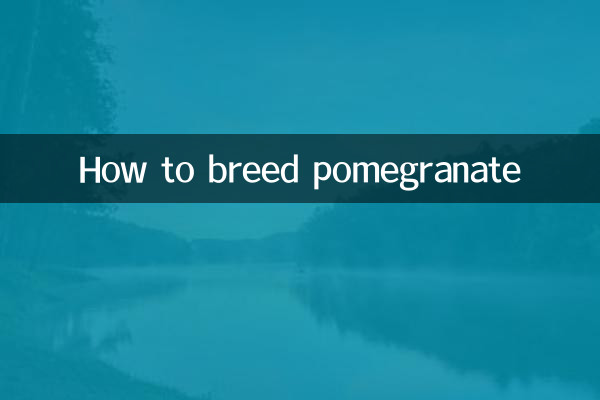How to breed pomegranate
Pomegranate is a nutritious fruit that not only has a sweet and sour taste, but also has high medicinal value. In recent years, more and more people have begun to try to grow pomegranates at home or in orchards. This article will introduce in detail the breeding methods of pomegranate to help you successfully plant healthy and high-yield pomegranate trees.
1. Basic information about pomegranate

Punica granatum (scientific name: Punica granatum) is native to Iran and Afghanistan and is a drought-resistant and cold-resistant fruit tree. The pomegranate tree is usually 2-5 meters tall, with a flowering period between May and July and a fruiting period between September and October. The fruits of pomegranate are rich in vitamin C, potassium, antioxidants, etc., and have high nutritional value.
| property | describe |
|---|---|
| scientific name | Punica granatum |
| country of origin | Iran, Afghanistan |
| Tree height | 2-5 meters |
| Flowering period | May-July |
| Fruit period | September-October |
2. Pomegranate breeding methods
1. Soil selection
Pomegranates have strong adaptability to soil, but loose, fertile and well-drained sandy loam is the best. The pH of the soil should be between 6.5-7.5, and overacid or overalkali will affect the growth of pomegranates.
| Soil type | Require |
|---|---|
| texture | Loose, good drainage |
| pH value | 6.5-7.5 |
| Fertility | Medium or above |
2. Planting time
The best time to plant pomegranates is in spring (March-April) or autumn (September-October). The temperatures in these two seasons are suitable, which is conducive to the rooting and growth of pomegranate trees.
| season | Features |
|---|---|
| spring | The temperature rises, which is conducive to rooting |
| autumn | Moderate temperatures are good for wintering |
3. Planting method
Pomegranates can be reproduced through seeds, cuttings or grafting. Among them, cuttings are the most commonly used method, with a high survival rate and can maintain the excellent traits of the parent.
(1) Cutting propagation
Choose annual strong branches, cut into 15-20 cm cuttings, insert them into moist sandy soil, keep the soil moist, and take root in about 1 month.
(2) Seed reproduction
Wash the pomegranate seeds and dry them, sow them in loose soil, cover 1-2 cm of soil, keep them moist, and germinate after about 2-3 weeks.
4. Daily management
(1) Watering
Pomegranates are drought-resistant, but they need appropriate watering during the growth period. The amount of water required during the flowering and fruiting period is large, so the soil should be kept moist but water accumulation should be avoided.
(2) Fertilization
Pomegranates need sufficient nutrients during the growth period. In spring, nitrogen fertilizer can be applied to promote branch and leaf growth, phosphorus and potassium fertilizer can be applied before flowering to promote flower bud differentiation, and compound fertilizer can be applied during the fruiting period to improve the quality of the fruit.
| Fertilization period | Fertilizer Type |
|---|---|
| spring | Nitrogen fertilizer |
| Before blooming | Phosphorus and potassium fertilizer |
| Result period | Compound fertilizer |
(3) Prune
Pomegranate trees need to be pruned regularly to keep the tree shape and ventilated and light-transmitted. Plastic surgery and pruning can be performed in winter to cut off weak and overly dense branches; light pruning can be performed in summer to promote flower bud differentiation.
5. Pest control
Common pests and diseases of pomegranate include aphids, red spiders, anthrax, etc. It can be prevented and treated by the following methods:
| Pests and diseases | Prevention and treatment methods |
|---|---|
| aphid | Spray imidacloprid or soapy water |
| Red Spider | Spray avermectin |
| anthrax | Spray wormwood or Bordeaux liquid |
3. Harvest and storage of pomegranates
When the pomegranate fruit matures, the peel will change from green to red or yellow, and cracks will appear. It is now ready to pick. After picking, the pomegranates can be stored in a cool and ventilated place for 1-2 months, or stored in the refrigerator for a longer storage time.
4. Summary
Pomegranate breeding is not complicated. As long as you master the key links such as soil, planting, management and pest control, you can successfully plant healthy and high-yield pomegranate trees. I hope this article can provide you with useful reference and wish you a happy planting!

check the details

check the details